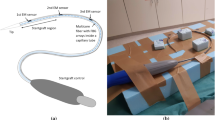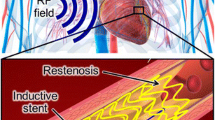Abstract
Purpose
Heart valve disease is commonly treated by minimally invasive procedures with guide wires and catheterization. The main purpose of this study is to find out whether an extension of the guide wire with a sensor can support the surgeon within the blood vessel to reduce X-ray necessity.
Methods
A smart guide wire is developed by an extension with a flex-bending sensor to evaluate the sensor signal with and without “blood” flow at a constant compression force. Various surgically relevant investigations are performed. For assessment, the mean temporal average of the moving averaged filtered ADC signal and a subsequent FFT are carried out.
Results
Results show that there is a smaller sensor signal when the applied force or bending at the sensor is higher. In all investigations, there was a different sensor signal. The flex-bending sensor can detect the effect of pulsatile flow. The smallest temporal averaged signal difference between reference and clamp in the front wire’s tip is 1.09%. For example, the mean temporal average of the filtered ADC signal for different clinically relevant scenarios is between 2550 and 2900.
Conclusions
The results show that the sensorized guide wire developed for catheterization can support aortic valve implementation. The sensor sensitivity is sufficient to detect even very small variations within the blood vessel and therefore is promising to support catheterization heart valve surgeries in future.






Similar content being viewed by others
References
Thaden JJ, Nkomo VT, Enriquez-Sarano M (2014) The global burden of aortic stenosis. Prog Cardiovasc Dis 56:565–571
Lindman BR, Clavel M-A, Mathieu P, Lung B, Lancellotti P, Otto CM, Pibarot P (2016) Calcific aortic stenosis. Nat Rev Dis Prim 2:1–28
Glauber M, Ferrarini M, Miceli A (2015) Minimally invasive aortic valve surgery: state of the art and future directions. Ann Cardiothorac Surg 4:26
Cocchieri R, Petzina R, Romano M, Jagielak D, Bonaros N, Aiello M, Lapeze J, Laine M, Chocron S, Muir D, Eichinger W, Thielmann M, Labrousse L, Rein KA, Verhoye JP, Gerosa G, Bapat V, Baumbach H, Sims H, Deutsch C, Bramlage P, Kurucova J, Thoenes M, Frank D (2019) Outcomes after transaortic transcatheter aortic valve implantation: long-term findings from the European ROUTE. Eur J Cardio-Thoracic Surg 55:737–743
Siontis GCM, Overtchouk P, Cahill TJ, Modine T, Prendergast B, Praz F, Pilgrim Th, Petrinic T, Nikolakopoulou A, Salanti G, Sondergaard L, Verma S, Jüni P, Windecker S (2019) Transcatheter aortic valve implantation vs. surgical aortic valve replacement for treatment of symptomatic severe aortic stenosis: an updated meta-analysis. Eur Heart J 40:3143–3153
Clayton B, Morgan-Hughes G, Roobottom C (2014) Transcatheter aortic valve insertion (TAVI): a review. Br J Radiol 87:20130595
Merkel S, Eikermann M, Neugebauer EA, von Bandemer S (2015) The transcatheter aortic valve implementation (TAVI)—a qualitative approach to the implementation and diffusion of a minimally invasive surgical procedure. Implement Sci 10:1–9
Sehatzadeh S, Doble B, Xie F, Blackhouse G, Campbell K, Kaulback K, Cahndra K, Goeree R (2012) Transcatheter aortic valve implantation (TAVI) for treatment of aortic valve stenosis: an evidence-based analysis (part B). Ont Health Technol Assess Ser 12:1
Judy JW (2001) Microelectromechanical systems (MEMS): fabrication, design and applications. Smart Mater Struct 10:1115
Khoshnoud F, de Silva CW (2012) Recent advances in MEMS sensor technology-mechanical applications. IEEE Instrum Meas Mag 15:14–24
Fiorillo AS, Critello CD, Pullano SA (2018) Theory, technology and applications of piezoresistive sensors: a review. Sens Actuators A Phys 281:156–175
Stefanova N, Hessinger M, Opitz T, Werthschützky R (2016) Characteristic of a force sensing guide wire for minimally invasive cardiac surgery. In: 2016 38th annual international conference of the IEEE engineering in medicine and biology society (EMBC). IEEE, pp 5220–5223
Gil B, Li B, Gao A, Yang G-Z (2020) Miniaturized piezo force sensor for a medical catheter and implantable device. ACS Appl Electron Mater 2:2669–2677
Han B, Yoon Y-J, Hamidullah M, Lin AT, Park WT (2013) Silicon nanowire based ring shape force sensor for sensorized guidewires. In: 2013 transducers & eurosensors XXVII: The 17th international conference on solid-state sensors, actuators and microsystems (TRANSDUCERS & EUROSENSORS XXVII). IEEE, pp 718–721
Lou L, Ramakrishna K, Shao L, Park WT, Yu D, Lim L, Wee Y, Kripesh V, Feng H, Chua BSY, Lee C KwongDL (2010) Sensorized guidewires with MEMS tri-axial force sensor for minimally invasive surgical applications. In: 2010 Annual international conference of the IEEE engineering in medicine and biology. IEEE, pp 6461–6464
Tanimoto M, Arai F, Fukuda T, Iwata H, Itoigawa, K, Gotoh Y, Hashimoto M, Negoro M (1998) Micro force sensor for intravascular neurosurgery and in vivo experiment. In: Proceedings MEMS 98. IEEE. Eleventh annual international workshop on micro electro mechanical systems. an investigation of micro structures, sensors, actuators, machines and systems (Cat. No. 98CH36176). IEEE, pp 504–509
Bandari N, Dargahi J, Packirisamy M (2021) Optical fiber array sensor for force estimation and localization in tavi procedure: design, modeling, analysis and validation. Sensors 21:5377
Entwurf KN Präparation und Charakterisierung von Führungsdrähten mit integriertem Silizium-Mikro-Kraftsensor für die Herzkranzgefäß-Katheterisierung
Kuhn N (2023) Feedback-giving guide wire for vaso-protective use in minimal invasive heart surgery. MCI Innsbruck
Bahl J (2015) Study of predictive power of moving averages as a tool of technical analysis. J Stud Manag Plan 1:103–114
Al-Mbaideen AA (2019) Application of moving average filter for the quantitative analysis of the NIR spectra. J Anal Chem 74:686–692. https://doi.org/10.1134/S1061934819070013
Vitello DJ, Ripper RM, Fettiplace MR, Fettiplace MR, Weinberg GL, Vitello JM (2015) Blood density is nearly equal to water density: a validation study of the gravimetric method of measuring intraoperative blood loss. J Vet Med 2015:1–4. https://doi.org/10.1155/2015/152730
Nader E, Skinner S, Romana M, Fort R, Lemonne N, Guillot N, Gauthier A, Antoine Jonville S, Renoux C, Dessources MDH, Stauffler E, Joly P, Bertand Y, Connes P (2019) Blood rheology: key parameters, impact on blood flow, role in sickle cell disease and effects of exercise. Front Physiol 10:1–14. https://doi.org/10.3389/fphys.2019.01329
Berstad DA, Knapstad B, Lamvik M, Skjølsvik PA, Tørklep K, Øye HA (1988) Accurate measurements of the viscosity of water in the temperature range 19.5-25.5°C. Phys A Stat Mech Appl 151:246–280. https://doi.org/10.1016/0378-4371(88)90015-5
Denisenko NS, Kulik VM (2017) In-house manufacturing of cylindrical silicone models for hemodynamic research. In: AIP conference proceedings. AIP Publishing, Vol 1893, No 1
Acknowledgements
We would like to thank Markus Gstir and Sandro Müller for developing the MOSFET circuit.
Funding
No funding was received for conducting this study.
Author information
Authors and Affiliations
Corresponding author
Ethics declarations
Conflict of interest
The authors declare that they have no conflict of interest. There were no human or animal studies involved.
Additional information
Publisher's Note
Springer Nature remains neutral with regard to jurisdictional claims in published maps and institutional affiliations.
Rights and permissions
Springer Nature or its licensor (e.g. a society or other partner) holds exclusive rights to this article under a publishing agreement with the author(s) or other rightsholder(s); author self-archiving of the accepted manuscript version of this article is solely governed by the terms of such publishing agreement and applicable law.
About this article
Cite this article
Berger, M., Kuhn, N., Pillei, M. et al. The development and testing of a smart sensorized guide wire for catheterization in a “blood” vessel phantom to support aortic valve implementation. Int J CARS (2024). https://doi.org/10.1007/s11548-024-03127-w
Received:
Accepted:
Published:
DOI: https://doi.org/10.1007/s11548-024-03127-w








